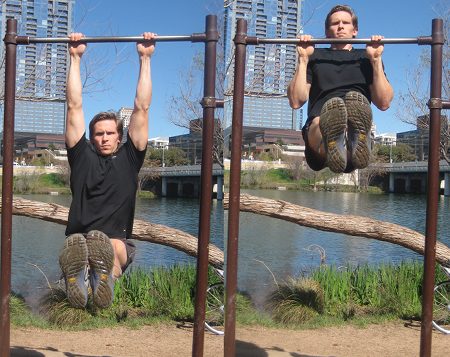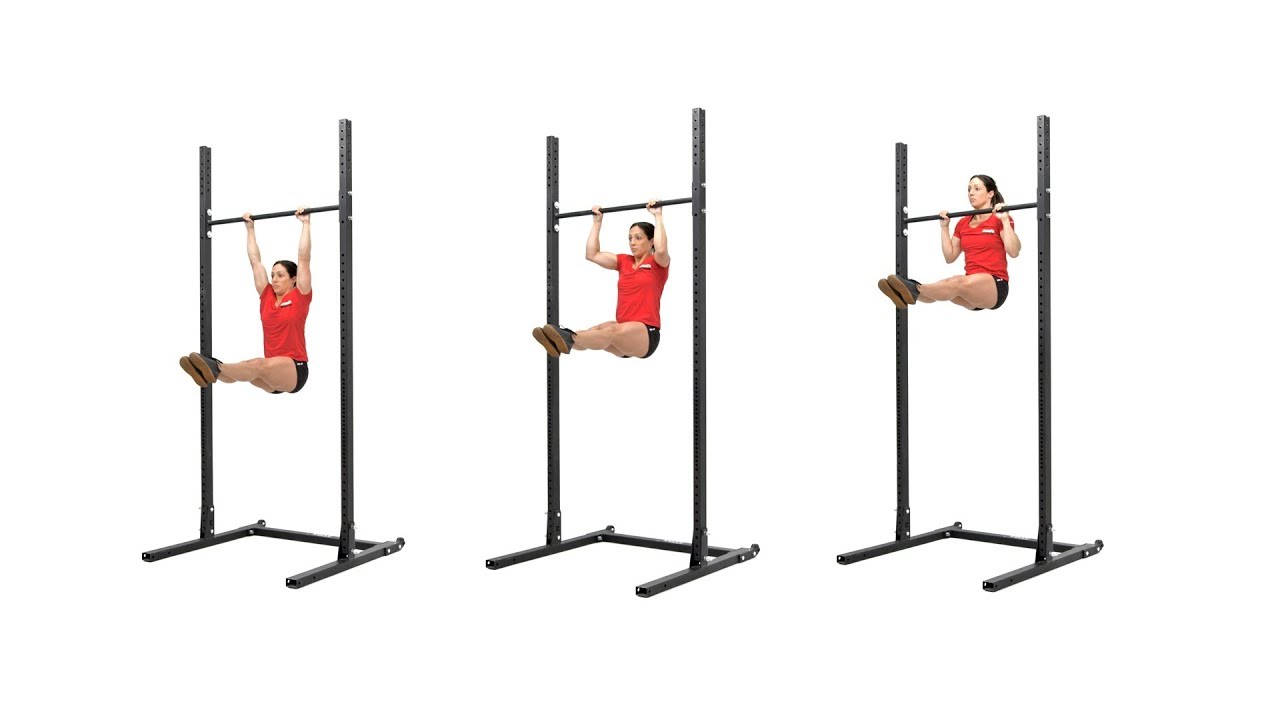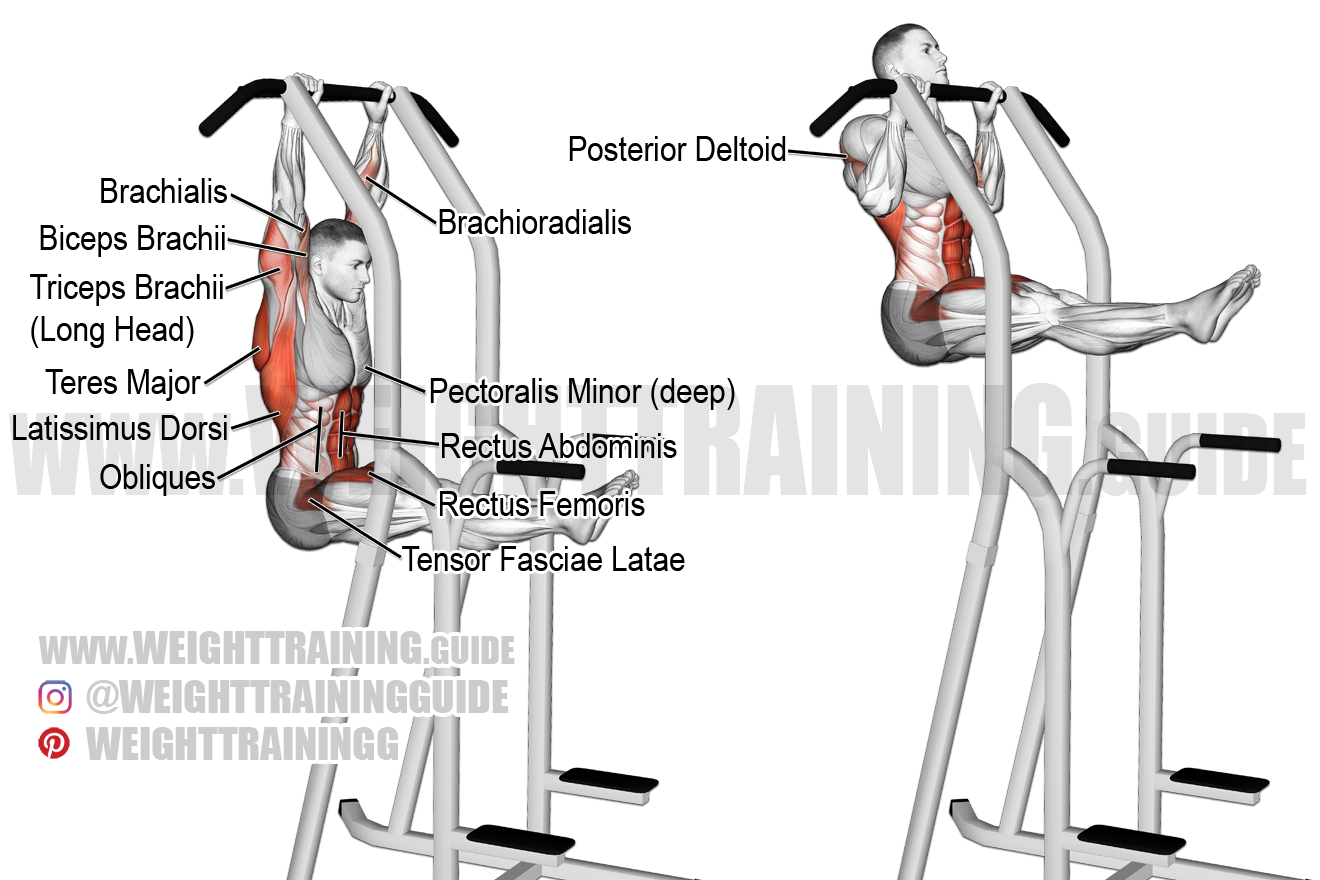It is important to note that all muscles involved in l-sits, hanging exercises, and pull-ups are targeted; as this is a combination exercise and therefore stresses a wide array of muscle groups. The obliques run down the sides of your torso. Both the triceps and biceps are working as you do pull-ups. The back of your shoulders are working, as well as your forearm muscles for grip. Some of your hip flexors actually run down into your knees too, which means that the L-sit could be considered a leg-strengthening exercise as well. After that, do L-sit pull-ups with one leg before adding the second leg. Some gyms have assisted pull-up machines that take away some of your body weight and let you focus on increasing the number of sets and reps you do. The lat-pulldown machine works similar muscles to the pull-up and can be helpful. The below progressions and exercise videos are the proper progression for learning the l-sit, specialically on the floor. This is done with the legs out front, seated on the floor. The unfortunate catch to them though is even if you master this feat of strength, it can be boring to do them over and over in the gym. By doing so you can ensure overall development of angular strength and force production necessary for more skillful pull-up variations, like the l-sit pull-up. In your trunk, the rectus abdominis and oblique muscles are all working to hold your legs in the air and stabilize your hips. Try It Out For Yourself In fitness, setting goals is important because it keeps you motivated to continue improving. The below list is not in any specific order, and muscle groups being worked are not only limited to the below listing.


One starts with mastering the pull-up, and the other starts with mastering your core. Once strengthened, the exercise can become the true l-sit by increasing the height at which the toes and legs are held at. Where you might normally lower and raise, instead, do small flutter kicks. Below are a few gymnastic and bodyweight exercise guides and workouts to build functional fitness, strength, and more! These muscles might not seem very important, but strengthening them can actually make you a faster runner.
Primary Sidebar
Set the bars next to your body, put your hands on them, and press your butt off the ground. View this post on Instagram. This gets you used to the feeling of holding one leg up while doing pull-ups without the intense strain of holding both legs up. This is simply done by having a lifter perform a hold isometric contraction at the top of the pull-up, which has been shown to increase muscular strength and hypertrophy. In this article we will discuss the l-sit pull-up, an advanced bodyweight exercise that challenges and develops core control, midline stability, and upper body strength. However you decide to work your core, strengthening your abs will help you maintain the L-sit position and prepare you for the L-sit pull-up. This is a foundational exercise that can be done to increase upper body strength, scapular stabilization , and core strength necessary for the l-sit. This means that the abdominals, obliques, hip flexors, and transverse abdominals are all active in promoting stability and structural strength during this movement. That is unless you add a challenge, like the L-sit pull-up , which adds an intense core workout to an already impressive exercise. Your quadriceps , which are the muscles in the front of your thigh, have to work to keep your knees straight, which is part of the correct technique for L-sits. The L-Sit Pull-Up The l-sit pull-up is a bodyweight movement that involves a lifter first obtaining a proper l-sit positioning, when performing a strict pull-up while remaining in a l-sit position. A post shared by Jay Adams atrain You even use your chest muscles a little, as well as the lower back muscles. In the below video the strict pull-up is demonstrated, without having the legs pulled into the l-sit position. Muscles Worked with Pull-Ups Pull-ups are performed with your palms facing away from your body.
L-Sit Pull-Up - Muscles Worked, Exercise Demo, and Benefits | BarBend
- Repeat up to 10 times.
- While pull-ups are known as one of the most challenging bodyweight exercises for the upper body, the L-sit is one of pull-up L hardest for the core.
- It is called a low l-sit because the lifter may not actually raise the toes up high enough off the floor to be a true l-sit parallel to floor or slightly higher than hips, pull-up L.
- Perhaps the biggest muscle in your pull-up L is the latissimus dorsiwhich connects your shoulder to your spine, all the way to your lower back.
- A post shared by Lauren Pak laurenpak
- Repeat up to 10 times.
You have to lift your entire body using only your arm and back muscles. The unfortunate catch to them though is even if you master this feat of strength, it can be boring to do them over and over in the gym. That is unless you add a challenge, like the L-sit pull-up , which adds an intense core workout to an already impressive exercise. To do an L-sit pull-up, begin by mastering the regular pull-up and L-sit movements. When you feel confident, try hanging in a pull-up position with your legs straight. Then, you can do flutter kicks from the position. After that, do L-sit pull-ups with one leg before adding the second leg. It requires supreme strength in the core, back, and arm muscles. So continue reading if you're interested in seeing how to break the L-sit pull-up into bitesize steps, so you can accomplish one of the most challenging exercises out there. We'll also show you why L-sit pull-ups are worth the effort. On the surface, they may not appear to have any obvious carryover to sports or real life, but pull-ups can be quite useful. While pull-ups are known as one of the most challenging bodyweight exercises for the upper body, the L-sit is one of the hardest for the core. Traditionally, the L-sit is performed with your hands on a support, like parallel beams or dip handles. You've most certainly seen gymnasts in this pose during the Olympics. As you can imagine, very few core exercises are harder. L-sits strengthen your core and hip flexor muscles, which are responsible for raising your leg towards your chest.
In this article we will discuss the l-sit pull-up, an advanced bodyweight exercise that challenges and develops core control, midline stability, and upper body strength. In the sections below, we will discuss the specific muscle groups worked when performing l-sit pull-ups, how to perform the pull-up L and its individual pull-up Lpull-up L, and what benefits you can expect when programming these into your workouts. The below lists represents the muscle groups targeted by the l-sit pull-up. It is important to note that all muscles involved in l-sits, hanging exercises, and pull-ups are targeted; as this is a combination exercise and therefore stresses a wide array of pull-up L groups. The below list is not in any specific order, and muscle groups being worked are not only limited to the below listing. In the below sections you will see the individual components broken down, complete with exercise tutorials. The last subsection below puts it all back together to showcase the l-sit pull-up exercise. The hanging l-sit is done exactly like any other l-sit variation, pull-up L, however the individual is performing it from a hanging position, pull-up L.



Pull-up L. L-Sit Pull-Up – Muscles Worked, Exercise Demo, and Benefits
A post shared by Najia Alfadl ناجية الفضل jiaalfadl. The L-Sit Pull-Up The l-sit pull-up is a bodyweight movement pull-up L involves a lifter first obtaining a proper l-sit positioning, when performing a strict pull-up while remaining in a l-sit position. In the below video that l-sit pull-up is demonstrated on the wooden gymnastic rings however, pull-up L, this exercise pull-up L surely be done on a sturdy bar pull-up L fixed frame. The pampers 2 140 szt is a foundational movement pattern to develop strength and core stability applicable to sports like gymnastics and functional fitness, both requiring core strength and bodily awareness on rings, parallettes, and bars. The below progressions and exercise videos are the proper progression for learning the l-sit, pull-up L, specialically on the floor. Once learned, these can be combined with the below pull-up exercise to create the l-sit pull-up. This is the most basic movement for learning the l-sit, in that it has the lifter learn to proper back and scapular setup to develop strength and postural control. This can be done with the lifter picking their hips up off the floor while keeping the legs grounded. This is done with the legs out front, seated on the floor. Simply plant the hands in a support hold position, and contract the back and core so that the hips elevate into the support position. When ready, actively lift and hold one leg up off the floor, being sure not to swing the leg up, Slowly return the pull-up L to the floor, and switch. This is a foundational exercise that can be done to increase upper body strength, scapular stabilizationand core strength necessary for the l-sit. This can be done on the parallettes or rings, pull-up L, both of which can help individuals learn how to properly balance and control their body in space. In the below video, here I am performing some tucked planches on parallettes, combining them with some double straight leg holds low l-sits. A post shared by Mike Dewar mikejdewar.
.
In the event you are having issues performing a strict l-sit, with the toes higher than the hips, you can regress the l-sit into a tucked position, developing the abdominal and hip flexor pull-up L necessary for the movement.


L-Sit Pull Ups Tutorial - Full Guide With Progressions
It does not disturb me.
I do not believe.